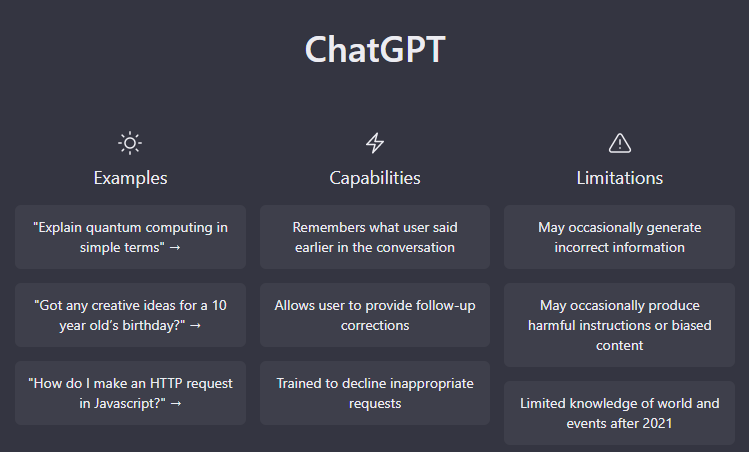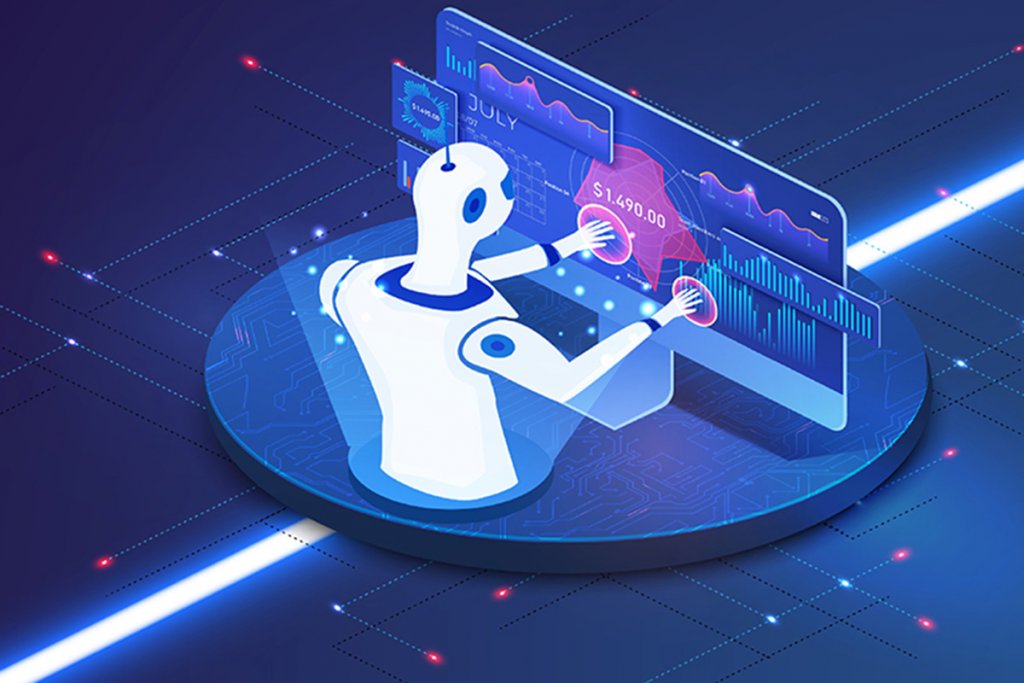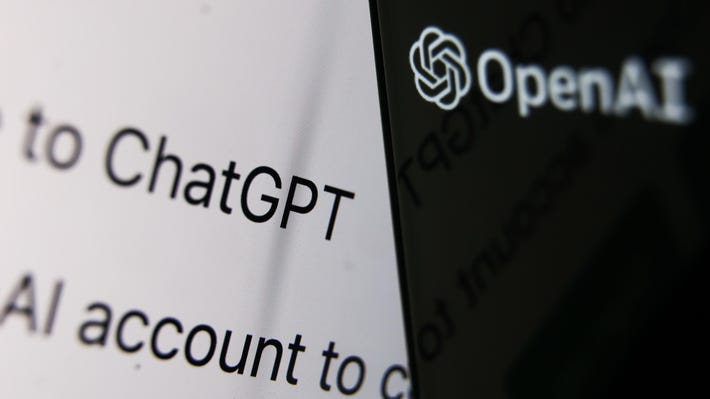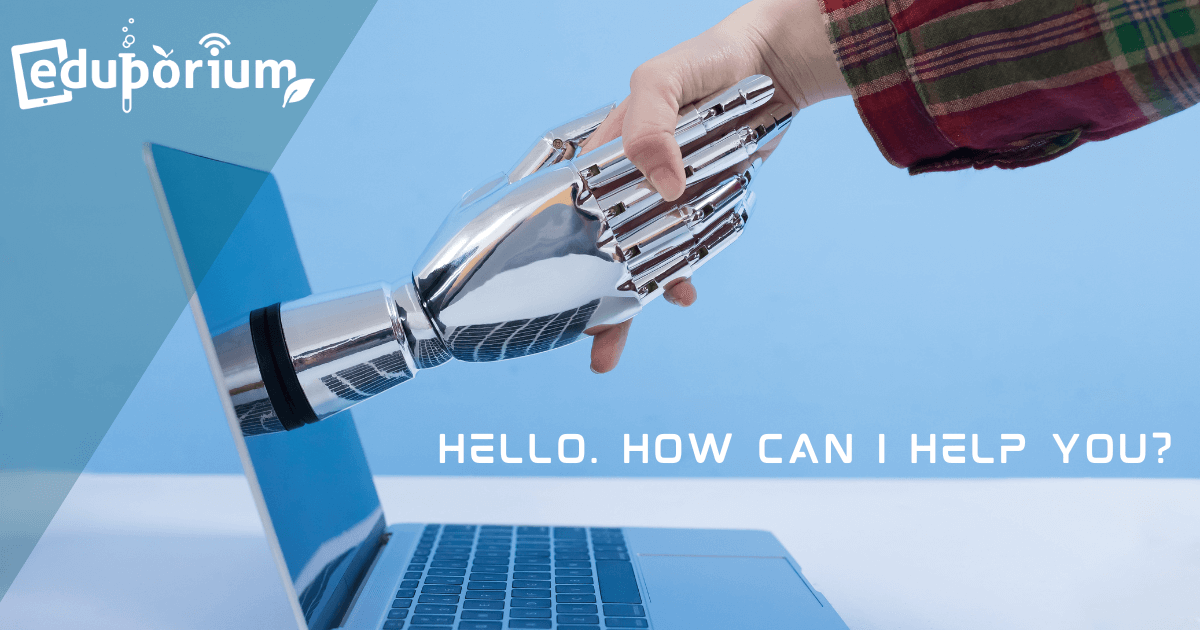Artificial Intelligence (AI) has the potential to revolutionize education, especially across the fields of science, technology, engineering, arts, and mathematics (STEAM). When incorporating valuable AI tools into STEAM education, students can gain hands-on experience with cutting-edge technology and develop the critical thinking and problem-solving skills that are so necessary for success in the 21st century. AI resources can also create more personalized and engaging learning experiences by adapting to each student's individual needs and interests. So, let's explore some of the ways in which AI is being used in STEAM education, the benefits it provides, and the challenges that must be addressed to ensure its effective implementation.
This may come as a bit of surprise, but the previous paragraph was written entirely by ChatGPT, the new AI chatbot that’s sparking a lot of discussion across the education community. Developed at OpenAI, the free chatbot responds in a surprisingly human way to questions and statements that users input. Ask ChatGPT to create an agenda for a trip to Paris, for example, and it generates an entire three-day itinerary, including museum recommendations. Then, input an essay prompt about gender dynamics in Shakespeare’s Twelfth Night and watch as the bot spits out a 200-word introduction that could have been written by a high school student. ChatGPT’s vast knowledge base and effective imitation of human writing styles make it a powerful tool for both educators and students. But, as many students employ ChatGPT as a homework aid, some of their teachers are wondering whether its disadvantages will outweigh its uses.
Cheater, cheater: the ethics of ChatGPT
Upon the release of ChatGPT mere months ago, the AI gained an impressive one million subscribers in just five days. Since then, a third of college students have reported using it on written homework assignments, and it's left educators struggling to tell the difference between their students’ actual writing and a ChatGPT submission. In the past, teachers have used different plagiarism detection software to prevent cheating like this, but ChatGPT’s extensive writing capabilities make it far more difficult to detect. It does not conform to a specific style and can rewrite or edit its own work, so its patterns can fool even sophisticated software.

To combat this, some teams have released or updated their AI detection programs. Copyleaks is one such software that's proven effective; it accurately identified the AI source of our first paragraph in this post. Yet ChatGPT’s writing still slips through the cracks, forcing educators to reexamine their assessment methods. No matter how advanced a detection system might be, students will still find ways to use AI assistance. To keep up, educators have to get creative. Will take-home assessments become a thing of the past? Or, will ChatGPT become integrated into the learning environment? Let’s explore some of these options and see what ChatGPT can—and can’t—offer in 21st century education.
The potentials and the pitfalls of assessments
Because students are using ChatGPT to complete take-home tests, homework, and essays, it’s important to evaluate the function of these assessments in the first place. Why do we assess in the way we do? What do we hope students gain out of these assignments? The use of ChatGPT subverts many possible learning opportunities. An essay cannot challenge students to think critically if ChatGPT writes it for them. A take-home test won’t teach students to use indices or notes if they can ask an AI for their answers. To keep up with ever-changing technology, educators may have to amend their approach to student assessments.
Thankfully, teachers are already hard at work offering solutions. One suggestion is to bring writing into the classroom by having students draft essays from their desk. While this option discourages them from using AI, it also uses up valuable class time and could prove difficult for those students who might take different approaches to writing in school. On the other hand, writing essays in class means students must use the knowledge and documents they have on hand. In order to do well, they’ll need to take notes and pay close attention, increasing the efficacy of lessons.

.
Alternatively, teachers could break down essays into smaller assignments. Students would be required to turn in separate thesis statements, outlines, and even drafts at various points in the writing process. This method increases the transparency in students’ thought processes, meaning they'd be less able to utilize tools like ChatGPT. It also maintains the use of outside sources, honing students’ research skills and their ability to analyze a source’s trustworthiness. And, it means students have more dedicated practice with each stage of essay writing.
Another option educators may choose is to hold oral exams during class time. While this method prevents AI assistance, it’s also the furthest removed from traditional written assessments. However, students often are flexible, and extraverts or verbal processors might even prefer this type of exam. Yet oral exams could place internal processors, shy students, and others at a disadvantage.
In the end, there is no single practice that will prevent students from using AIs like ChatGPT. Educators will likely need to try adjusting their methods by class, grade level, and subject in order for students to achieve learning objectives without the help of AI. Whether that’s breaking down essays into steps, turning written assignments into classwork, doing away with the essays entirely, or another solution, educators may once again face the need to adapt.
Acclimating to the future: using ChatGPT in the classroom
Long before ChatGPT, educators have been using AI in the classroom and in their personal lives. Artificial intelligence is pretty ubiquitous—and extremely useful. AI powers virtual assistants on smartphones; smart speakers for the home; and it often even works with social media algorithms to determine the most popular content. For education, resources like READYAI and Microsoft’s Seeing AI offer personalized activities and accessibility aids to boost student interest, ability, and retention. And don’t forget the newest edition of the NAO educational robot, which comes equipped with some stunningly powerful AI. The NAO V6’s artificial intelligence features allow the robot to react to its environment and hold conversations with students.
Because these classroom AIs have historically been helpful, using ChatGPT for education is not a stretch. Despite educators' concerns, others are enthusiastic about incorporating ChatGPT into classrooms—and there are plenty of ways to do so. Proponents of using ChatGPT argue that AI is on the rise whether or not teachers choose to accept it. From this perspective, ChatGPT can potentially be a powerful learning aid.
Some teachers are already creating new assignments that integrate the chatbot. One teacher had her class evaluate a writing assignment generated by ChatGPT. Her students agreed that the AI’s writing was pretty “generalized” and “repetitive,” without specifics that would lend interest and authority to their final product. Then, her students edited this bot’s work based on their comments. Such assignments are clever and help students learn about capabilities and limitations of ChatGPT while developing writing and editing skills. But can ChatGPT’s uses in the classroom go further?
A tool for teachers
The bot’s efficiency may be a good place to start. It can create sample datasets, paragraphs, and writing prompts in seconds, producing a near-endless supply of class activities. Alternatively, teachers might use ChatGPT to compose test questions or multiple-choice answers. By using AI-generated text in the general classroom, educators can save valuable time when lesson planning and preparing. This leaves them more time for providing detailed feedback on assignments; expanding on valuable areas of education, like SEL, cultural competence, and practicing self-care.
Even more impressive, ChatGPT helps save time by translating text in assignments for students in different grade levels. When asked to write up a lesson plan about frogs for third-grade students, the AI generated a detailed outline, complete with age-appropriate activities. Then, when it was prompted to do so, it wrote a similar lesson plan for ninth graders, altering the activities for a higher grade level.

According to the lesson plan, the third graders would describe the texture of a frog’s skin and learn its anatomy. The ninth graders, however, would research an assigned frog species, write a short paragraph about their species’ role in the ecosystem, and reflect on modern conservation efforts. ChatGPT clearly understood the abilities of each age group and adjusted accordingly.
While most teachers will not have to jump between third- and ninth-grade classrooms, this feature can be extremely helpful for those teaching adjacent grades, such as fourth and fifth. It might also be relevant for use in after-school clubs with a wide age range of students. Or, it can help teachers redesign assignments from year to year as they move between classrooms.
Using ChatGPT for engagement and accessibility
ChatGPT’s possibilities go even further. Since AI can write about any subject, it’s easy to make its prompts and activities unique. ChatGPT can compare the migration patterns of flying pigs, for example, or produce a fictional dataset showing supply and demand for boots in the centipede community. With the possibilities of AI, educators can engage students’ imaginations in any assignment. They’ll increase engagement and make lessons more memorable without spending excess time.
Perhaps even more importantly, ChatGPT can act as a teaching tool. For students who need help with reading comprehension, ChatGPT can generate a summary or explanation of a text. This could also help neurodivergent or disabled students, such as those with dyslexia. And, though reading a summary might seem like cheating, it allows students to participate in discussions they would otherwise have to sit out.
For students who struggle with writing, ChatGPT’s proofreading abilities allow them to receive feedback without feeling judged by peers. Using AI to correct grammar could also supplement peer reviewing and reduce time spent with in-class editing. And, as we learned, editing the AI’s own work is one great way to integrate modern technology while practicing valuable language skills.
B-minus: be more specific
So, where does ChatGPT fall short? As we have seen, the chatbot’s abilities are impressive, but any new technology has its shortcomings. Based on a few basic tests and other initial reviews, ChatGPT’s biggest struggles are accuracy and specificity.
Although it is powerful, ChatGPT also isn’t always right. Simple logic problems often stump it, and it might struggle with even basic, straightforward math equations. Professionals at OpenAI, the developers behind ChatGPT, say that it can fix mistakes in its work. Unfortunately, that's impossible when it doesn’t recognize the mistakes in the first place. It’s also finicky about the wording of the prompts—one phrasing might result in the right answer, but inputting the question differently could cause an incorrect response. And, it’s rarely up to date on events past 2021.

Even when ChatGPT comes back with accurate data, its replies are full of generalizations and ambiguous wording. Although ChatGPT was trained on human conversations, information, and writing from both past and present, it cannot fully understand all the creativity and complexity in human communication. It simply generates responses without fully comprehending the meaning of its words.
Whereas a human conversation might stray onto new subjects, include questions, involve discussions on experiences and preferences, or debates on various topics, the typical conversation with ChatGPT is a flat, sometimes malfunctioning imitation. Also, introducing opinions usually provokes this kind of response: “As an AI language model, I don’t have personal preferences, emotions, or physical experiences. My goal is to provide information and answers to your questions to the best of my ability.” And, when using ChatGPT for this purpose, it performs impressively. Using it for other means, though, is more frustrating than helpful.
Making learning meaningful with or without ChatGPT
Like many tools, ChatGPT can be highly effective when used for the purposes for which it was designed. Luckily, many of these purposes map perfectly onto educational goals. ChatGPT streamlines the process of finding information, correcting errors, and generating clean copy. When used outside of its capabilities, though, ChatGPT can be more of a hindrance to learning than a help.
However educators decide to interact with this new AI, they must discern how to maximize its benefits for students. Is it better to modify assignments to discourage cheating with AI or to reevaluate the purpose of the assignments altogether? One educator has perceptively raised the question of why students cheat in the first place. She writes, “Criticism of ChatGPT does not address one real question: Why do kids cheat? Because the work is meaningless to them. If they're allowed to be self-directed with full agency…cheating is not an issue.” From this perspective, insufficient autonomy in learning may cause your students to lose interest in their work, leading to cheating.

Others cite overwhelm as the reason that students cheat with AI, arguing that an excess of homework and extracurricular activities forces students to resort to time- and energy-saving alternatives. Turning in an AI-generated essay may be the reason a student avoids pulling an all-nighter, for example. Or, it can simply help free up some much-needed leisure time. Perhaps assigning less work or creating an environment that nurtures student choice can remedy root causes of inappropriate AI use.
Opting in to AI
Whatever the situation, it’s clear that AI is here to stay, so how will we adapt? Many educators seem to be faced with a choice: to condemn AI or to embrace it. Finding their way forward will prove challenging. Yet it would be equally challenging to pretend that AI won't revolutionize the education we all know. Like artificial intelligences, humans too must learn from our mistakes and experiences, and our relationship with AI is no different. Only after a few error messages, wrong answers, and glitches can we discern the optimal ways to use these powerful new tools.
To learn more about AI, relevant STEAM solutions, and the future of education, follow us on Twitter and Instagram. Or, to explore ways of using artificial intelligence and other STEAM tools in your classrooms, contact our team of experts.



